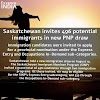Canada proceeded with its immigration record-establishing tone by inviting 341,000 newcomers in 2019. This is just the fifth time in its history that it has invited in excess of 300,000 migrants in a single year (different occasions were 1911-1913 and 2018).
Canada also exceeded the target it set in its 2019-2021 Immigration Levels Plan (330,800 immigrants) by more than 10,000 immigrants.
The nation additionally adhered to its arrangement by inviting 58 percent of its newcomers under the monetary class, while 27 percent landed through family sponsorship, and the staying 15 percent were invited under the evacuee class.
Canada also exceeded the target it set in its 2019-2021 Immigration Levels Plan (330,800 immigrants) by more than 10,000 immigrants.
The nation additionally adhered to its arrangement by inviting 58 percent of its newcomers under the monetary class, while 27 percent landed through family sponsorship, and the staying 15 percent were invited under the evacuee class.
 |
| exxenceindia |
25 per cent of new immigrants came from India
India remains the main source country of newcomers to Canada. The approximately 86,000 Indians who became permanent residents in 2019 accounted for 25 per cent of all newcomers to Canada. China was a distant second accounting for 9 per cent of newcomers, followed by the Philippines which accounted for 8 per cent of new immigrants. Nigeria, the United States of America, Syria, Eritrea, South Korea and Iran rounded out the top 10 source countries.
45 per cent of newcomers settled in Ontario
Ontario keeps on being by a wide margin the top goal for newcomers, inviting 45 percent of the national offer in 2019. Its offer expanded by two rate focuses from 2018. This might be clarified by the Quebec government's choice to lessen its outsider admission by 20 percent in 2019. Subsequently, Quebec fell two spots in 2019 to the fourth driving goal of newcomers to Canada. English Columbia moved into runner up as it invited 50,000 immigrants, with Alberta in third place.
Manitoba enjoyed a very strong immigrant intake as it welcomed nearly 19,000 immigrants last year, a 24 per cent increase compared with its 2018 intake. Saskatchewan’s immigration levels were nearly identical as in 2018, with the province welcoming nearly 16,000 newcomers.
Migration to Atlantic Canada kept on expanding, with Nova Scotia and New Brunswick encountering the biggest additions. Nova Scotia saw its admission ascend by 27 percent to more than 7,500 migrants while New Brunswick appreciated a 30 percent gain as it invited 6,000 newcomers.
35 per cent went to the Greater Toronto Area
More than one out of three newcomers decided to settle in the More noteworthy Toronto Territory (GTA). The GTA invited more outsiders (118,000 newcomers) than the four Atlantic regions, Quebec, Manitoba, Saskatchewan, and Canada's three domains joined.
Vancouver was the second leading city as it welcomed 40,000 immigrants, followed by Montreal (35,000) and Calgary (nearly 20,000).
Canada's four biggest urban communities (Toronto, Montreal, Vancouver, and Calgary) together invited 62 percent of all newcomers to the nation, down somewhat from their 64 percent share in 2018. The decrease is because of Quebec's choice to diminish its migration levels as Montreal's admission fell by about 10,000 newcomers a year ago.
Canada could welcome up to 360,000 immigrants in 2020
As indicated by its 2019-2021 immigration Levels Plan, the government is focusing on an extra 341,000 newcomer appearances in 2020. Since this objective was met a year ago, Canada may surpass it again this year. Actually, the arrangement gives Canada the adaptability to greet up to 360,000 newcomers in 2020. We will have greater clearness when Migration Clergyman Marco Mendicino tables the government's 2020-2022 immigration Levels Plan sooner rather than later—possibly inside the coming month.














0 Comments